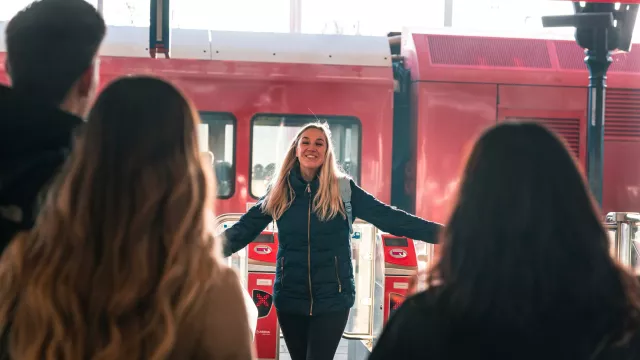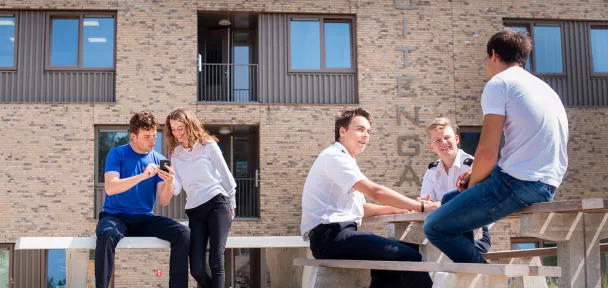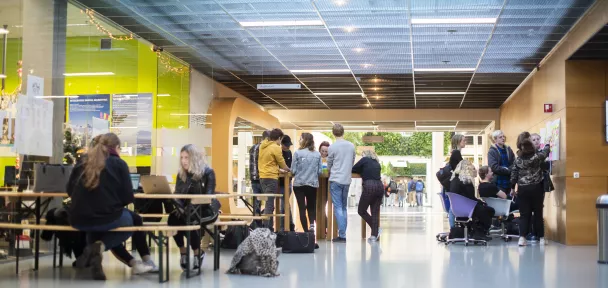The Netherlands has an excellent infrastructure and, as a major international transport hub, is easily accessible from practically anywhere in Europe and beyond. Find out how you can best organise your journey to the Netherlands and get top tips for travelling around once you're settled.
Car
The Dutch road network is extensive and well-maintained - and as the country is fairly small, nothing is really far away.
Bear in mind
The speed limit on motorways is 100km/h during the day and if you need to use your mobile phone, it has to be hands-free. You're advised to have an emergency triangle and safety vest in your car and it's useful to also have a spare set of lights, a life hammer, a first aid kit and a torch. And don't forget an emergency charging cable for your mobile phone!
If you don't have your own car, but really need one for a trip, you can of course rent a car (provided you have a driver's licence!). The Netherlands also has various car share systems in place, such as Greenwheels (which you can also link to your public transport travel card. See Greenwheels share car l A car when you need one | NS for more information.
Schiphol Airport
If you arrive at Schiphol airport, you can take a train or taxi to the different student cities. Train tickets costs around €30 from Schiphol to, for instance, Meppel, Assen, Emmen, Groningen or Leeuwarden. Check the travel planners above to prepare your journey.
You can book a taxi in advance through https://schipholtraveltaxi.nl/en/. When you arrive at Schiphol airport you will need to go to the STA desk (see map below) with your voucher. We strongly advise you book your taxi in advance. If you would rather grab a taxi upon arrival, simply follow the signs to the official taxi stands. Please do not trust taxi drivers wearing yellow jackets or any other persons that offer you a taxi outside the official taxi waiting area as they are not reliable.
The costs for a pre-booked taxi, for instance, from Schiphol to Leeuwarden is around €150. A regular taxi transfer can be €300 or more.
Eindhoven or Maastricht Airport
If you arrive at one of the other airports in the Netherlands, you can plan your domestic travel using the public transport planner:
- Public transport (including trains, busses, trams, metro, etc.): https://9292.nl/en
International Airport
If you arrive at one of the airports in one of our neighbouring countries, you can use the international train planner to plan your trip to the Netherlands:

Travel in the Netherlands
The Netherlands really is pretty easy to get around and you combine different forms of transport in one trip.
Car
The Netherlands is easy to get around and the road network is extensive and well-maintained. And as the country is fairly small, nothing is really far away.
The speed limit on motorways is 100km/h during the day and if you need to use your mobile phone, it has to be hands-free. You're advised to have an emergency triangle and safety vest in your car and it's useful to also have a spare set of lights, a life hammer, a first aid kit and a torch. And don't forget an emergency charging cable for your mobile phone!
If you don't have your own car, but really need one for a trip, you can of course rent a car (provided you have a driver's licence!). The Netherlands also has various car share systems in place, such as Greenwheels (which you can also link to your public transport travel card. See Greenwheels share car l A car when you need one | NS for more information.
Bike
Cycling is a really easy way of getting around in the Netherlands. Cities and towns have special cycle lanes and other road users are used to cyclists so it's much safer than in most countries. It's often quicker to get around town on a bike than by car or public transport and you'll quickly see how skilled the Dutch are at carrying practically anything on their bikes.
It's worth buying a second-hand bike rather than a new one to save money. Or you could rent one with a monthly payment. The bike must have good lights (white light in the front, red light at the back) especially in the winter as the police regularly check cyclists for these lights (and could fine you €75 if the lights aren't working). You'll also need to make sure you have a good lock, preferably with a wheel lock and a chain lock.
It's good to note that if you use your phone while cycling, and you're not using it handsfree, you can be fined €170.

Bicycles (buying and renting)
Public transport
The Dutch public transport system is really well linked so connections between trains, buses and even ferries are generally pretty smooth. The payment system is also linked with trains, buses, trams and metro systems all using the public transport smart card, the ‘OV-chipkaart’. You can also check in and out of the public transport system using your debit card, credit card, smartphone or wearable. This is an easy method if you're on holiday in the Netherlands but for longers stays, it's worth getting an 'OV-chipkaart'.
You can get single-use card from a public transport company (for instance, when you board a bus), but an anonymous ov-chipkaart may be more useful. It costs just €7.50 and can be used by more than one person (though not at the same time!). You simply load credit onto it for your journey at a sales point (such as the ticket machine at the train station) and then check in by swiping it across the screen on a gate or card reader at the train station, on the bus or in the metro. At the end of your journey, hold your ov-chipkaart against a gate or card reader again to check out. The display will show the cost of your journey and how much credit you have left on your card.
If you often travel by public transport, a personal ov-chipkaart is a good idea. It means you can add personal travel products like a monthly pass, travel on credit or set it to automatically reload credit and see all your travel details online. It also means you can rent an OV-bike (which is pretty cheap) at almost every train station in the Netherlands.
*if you are an EU student entitled to a Dutch student grant, you'll also get a student travel product (ie free travel during the week or weekend) - and that means you'll need a personal ov-chipkaart. Find out more about student loans & grants.
Super handy for non-EU international students: the Student Mobility Card. You sign up for just €15 then pay a €4.50 monthly subscription fee. Particularly useful if you're going to be travelling by bus, it gives you:
- 15% off-peak discount on national trains (NS)
- 40% off-peak discount on local buses (Qbuzz) + trains (Arriva)
- Access to all public transport: train, tram, metro, bus
- a monthly invoice of your travel costs
Cards can be shipped to any EU or Dutch address. Order yours now and start saving!
Planning your trip
Arriva and the Dutch Railways (NS) are the two transportation agencies within our province. Both have a handy travel app with which you can also buy your travel tickets directly.
To plan your trip from door to door you can make us of the website www.9292.nl/en or download the app via IOS or Android.



